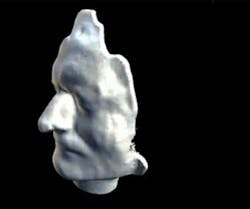Kinect used to create 3-D death mask of Newton
Researchers at Microsoft Research Laboratory (Cambridge, UK) have used a Kinect camera to produce the first ever 3-D scan of Sir Isaac Newton's death mask.
Newton was an English physicist and mathematician, and arguably the greatest scientist of his era. Newton’s single greatest work, Principia Mathematica was published in 1687. It showed how a universal force, gravity, applied to all objects in all parts of the universe.
The mask was created to serve as a likeness for future sculptures of the scientist. It is now held in the archives of the Royal Society, of which Newton was President at the time of his death.
The artist who made the mask is unknown, but the version that was scanned at Microsoft was owned by the 18th century French sculptor Louis-François Roubiliac, who used it to carve a marble bust of Newton and to make a statue of Newton in Trinity College Chapel in Cambridge, England.
The results of the scan can be seen on the web site of The Royal Society (London, UK) here.
Recent stories on the Kinect from Vision Systems Design that you might also find of interest:
1. Kinect API makes low-cost 3-D imaging systems attainable
Microsoft's Kinect is stirring up new interest in 3-D imaging due to its low cost and 'hack-ability' by novices and experts alike.
2. Kinect software assists physical therapists
The West Health Institute (La Jolla, CA, USA) has developed a software application for Microsoft's Kinect for Windows platform that can help physical therapists ensure that patients perform exercises correctly.
3. Kinect could help medics estimate radiation dose from CT scanner
Researchers at the Hospital of the University of Pennsylvania are investigating whether a system based around the Microsoft Kinect could be used to help predict the precise dose of ionizing radiation that patients require during a CT scan by providing an accurate estimate of whole-body volume.
4. Free toolkit helps Labview developers interface to the Kinect
Researchers from the school of mechanical engineering at Leeds University (Leeds, UK) have been crowned winners of the Student Design Competition at National Instruments NI Week in Austin, Texas for creating a LabVIEW application programming interface (API) for Microsoft's Kinect software development toolkit (SDK).
5. Kinect system tracks construction workers to analyze on-the-job movements
University of Calgary (Calgary, Canada) researchers have developed a system around the Microsoft Kinect sensor that can be used to track construction workers.
Vision Systems Design magazine and e-newsletter subscriptions are free to qualified professionals. To subscribe, please complete the form here.
-- Dave Wilson, Senior Editor, Vision Systems Design
